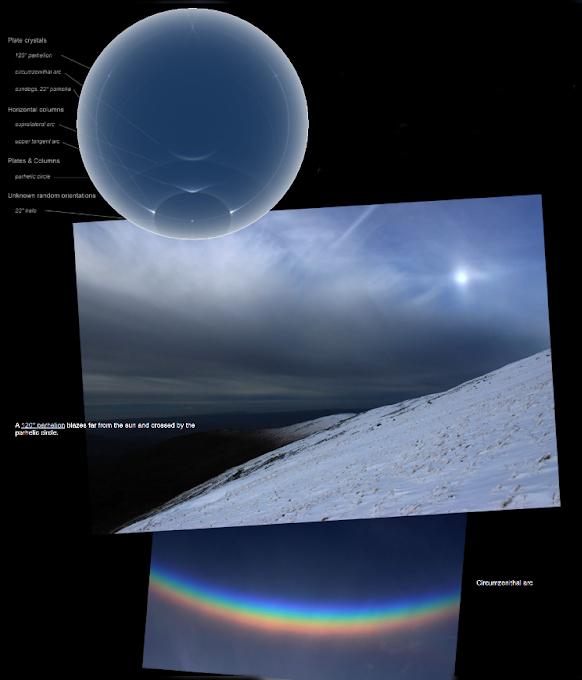OPOD - Wales Halos January 2012
OPOD - Wales Halos January 2012: A Spectacular Display of Atmospheric Optics
On the 28th of January, the UK was treated to a mesmerizing spectacle of halo displays, and Wales was no exception. Photographer Graham A Stephen captured stunning images of these atmospheric phenomena while exploring the breathtaking Carneddau Mountains. The images showcase a variety of halos, arcs, and false suns, created by the intricate interplay of sunlight with ice crystals suspended in the atmosphere.
The display was brought to life by an assortment of ice crystal shapes, including horizontal hexagonal plate crystals, horizontal columns, and randomly oriented hexagonal prisms. These crystals acted as tiny mirrors, bending and refracting sunlight to produce an array of optical phenomena that fascinated onlookers.
One of the most striking features of the display was the intense and spectral circumzenithal arc positioned directly overhead. This arc was formed by plate crystals, which interacted with sunlight to create a beautiful band of colors. Adjacent to the circumzenithal arc, a fainter supralateral arc could be observed. This arc, characterized by its widely spread colors, resulted from sunlight entering the side faces of column crystals and exiting through their hexagonal end faces. The supralateral arc is often mistaken for a rarer 46° halo.
Adding to the enchantment of the scene was a bright sundog, created once again by plate crystals. This sundog merged seamlessly into the white parhelic circle, which is formed by crystals of various types. A noteworthy feature within the parhelic circle was the presence of a false sun known as a 120° parhelion. This parhelion, always appearing white, is often overlooked when it appears against cloud cover. It is produced by rays that undergo three internal reflections within plate crystals.
It is important to note that while crystals are traditionally depicted with regular hexagonal cross-sections, they can actually have irregular shapes. However, the interfacial angles of these crystals remain constant. This variability in crystal shape adds to the complexity and uniqueness of each atmospheric optics display.
To provide a clearer visualization of the halos observed in Wales, a HaloSim ray tracing simulation has been included. The simulation showcases a 120° parhelion blazing far from the sun, intersected by the parhelic circle, and a prominent circumzenithal arc.
The January 2012 halo display in Wales was a captivating example of atmospheric optics at its finest. The intricate interplay between sunlight and ice crystals created a symphony of colors and shapes that left observers in awe. Whether it was the vivid circumzenithal arc, the delicate supralateral arc, or the false suns scattered throughout the scene, each element added to the overall grandeur of the display. Such captivating natural phenomena serve as a reminder of the hidden wonders that can be found in the sky above us.

UK Halos, Wales ~ The UK saw widespread halo displays on 28th January. Graham A Stephen (site) took these images while walking in the Carneddau Mountains of Wales. The top picture is from the slopes of Carnedd Gwenllian looking towards Carnedd Llewelyn and Yr Elen All images ©Graham A Stephen, shown with permission
 Horizontal hexagonal plate crystals, horizontal columns and some kind of randomly oriented hexagonal prisms, perhaps in clusters, produced the display.
Horizontal hexagonal plate crystals, horizontal columns and some kind of randomly oriented hexagonal prisms, perhaps in clusters, produced the display.
An intense and spectral circumzenithal arc from plate crystals is overhead. Tangent to it is a fainter supralateral arc, its widely spread colours showing to the right of the top image. Sun rays entering a side face of column crystals ant leaving through a hexagonal end face generate this arc, often mistaken for a rarer 46° halo. Similar column crystals produced the gull wing shaped upper tangent arc atop the 22° halo.
A bright sundog (plate crystals again) merges into the white parhelic circle. Crystals of all types contribute to the latter.
Another false sun, a 120° parhelion, is found some distance around the parhelic circle. This parhelion is always white and often overlooked when it appears against cloud. Rays internally reflected three times inside plate crystals make the 120° parhelion. It is brightest when the plates are thick or when they are of triangular aspect - alternate hexagonal sides long and short. Crystals are traditionally drawn with regular hexagonal cross sections but in reality they can be quite irregular. Their interfacial angles are always constant though.
At left a zenith centred HaloSim ray tracing shows the halos.
A 120° parhelion blazes far from the sun and crossed by the parhelic circle.
Circumzenithal arc

Note: this article has been automatically converted from the old site and may not appear as intended. You can find the original article here.
Reference Atmospheric Optics
If you use any of the definitions, information, or data presented on Atmospheric Optics, please copy the link or reference below to properly credit us as the reference source. Thank you!
-
<a href="https://atoptics.co.uk/blog/opod-wales-halos-january-2012/">OPOD - Wales Halos January 2012</a>
-
"OPOD - Wales Halos January 2012". Atmospheric Optics. Accessed on November 25, 2024. https://atoptics.co.uk/blog/opod-wales-halos-january-2012/.
-
"OPOD - Wales Halos January 2012". Atmospheric Optics, https://atoptics.co.uk/blog/opod-wales-halos-january-2012/. Accessed 25 November, 2024
-
OPOD - Wales Halos January 2012. Atmospheric Optics. Retrieved from https://atoptics.co.uk/blog/opod-wales-halos-january-2012/.